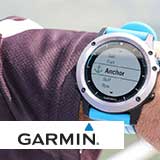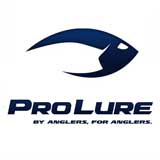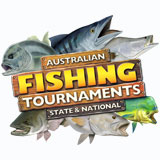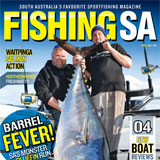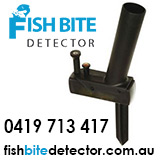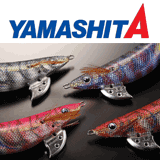Species ID
View AllBlue Swimmer Crab
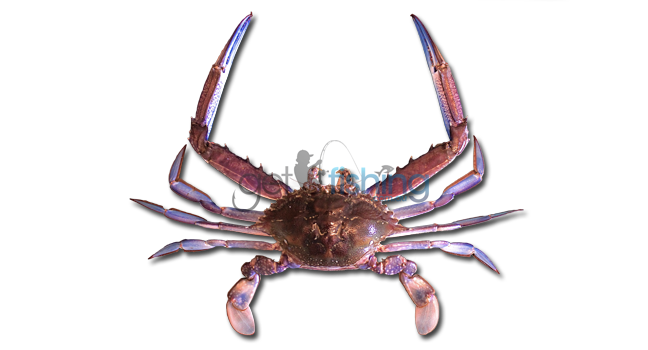
The blue swimmer crab belongs to the family Portunidae, or swimming crabs, which have characteristically flattened hind legs used as paddles for swimming. The blue swimmer male has a bright bluish colouration whereas the female, or jenny, is less brightly coloured with smaller claws and a more rounded abdominal flap than males. The distinguishing feature of the blue swimmer, is the long spine on both sides of the carapace. On either side of the carapace, between the long spine and the eyes, they have a row of 9 spikes called horns.
Other names
Blue manna Crabs, Blueys
Common size
10-14cm carapace width
Related species
Mud Crabs, Sand/Surf Crabs
Lifespan
Around 3-4 years
Habitat
Blue swimmers live in shallow coastal waters, estuaries, bays and inlets up to 50m deep. Their tendency is for a sandy and/or seagrass substrate, and in estuaries prefer sandy areas with higher tidal flow.
Reproduction
Blue swimmers begin their life as larvae known as zoea, drifting in coastal waters and bays before settling in the shallows. They are fast growers and begin their adult life-hood at approximately one year and 9cm width. They mate in autumn and spawn between spring and summer at the mouth of estuaries or in the ocean. Females may spawn more than once in a season and produce between 180,000 – 2 million eggs at a time.
Diet
Blue swimmers are not fussy eaters. They are opportunistic scavengers as well as aggressive predators and occasional weed eaters. They prey on benthic organisms such as molluscs and worms and are capable of catching small fish and crustaceans. They’ll readily feed on dead fish and from time-to-time feed on a bit of algae or seagrass.
Catch care
Blue swimmers should be cooked fresh, and the best way to ensure this is to make sure they are alive up until the time of cooking. Blue swimmers can survive out of water for hours and the most ethical way to keep them while on the water is by storing in an esky on ice or in a wet hessian bag (or similar) in a cool place. Alternatively, keep your crabs in an ice slurry, but be sure to dispatch them correctly first as they will drown slowly in the slurry. See this video on how to humanely kill a crab.
Information courtesy of Department of Fisheries WA and Graham J. Edgar (Australian Marine Life)
Blue swimmers are found in coastal waters and estuaries around Australia and are well spread Internationally. They are widely distributed in the Indian and Pacific oceans particularly throughout the Indo-Pacific region. They range between the south east coast of Africa following the coast north and east all the way across to India, Malaysia and up to southern Japan. They are found throughout Indonesia and Papua New Guinea and neighbouring islands.
Blue swimmers are arguably Australia’s favourite eating crab, closely contested with the mud crab. They are highly sought by commercial and recreational fishers for their tasty white meat. They are fantastic simply boiled in salt water or in a variety of fancy dishes, especially with chilli. Never put them into boiling water alive as this will toughen the meat and cause the legs and claws to fall off. Instead, dispatch your crabs humanely before cooking by putting them in the freezer for 10-20 minutes, then place on their back and sever the two main nerve centers by ike jimeing straight through at the point of the abdominal flap, and again from just below the mouth backwards at a 45 degree angle. See our recipes section for the best Chilli Crab recipe ever!
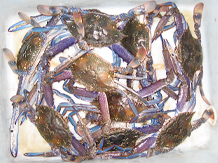
- From the family Portunidae (swimming crabs)
- Blue swimmers grow to 1kg and 25cm carapace width
- Their claw span can reach up to 80cm
- They can swim freely throughout the water column
- When courting, males can stay connected to females for up to two weeks at a time
- Large females can produce up to 2 million eggs each spawning, sometimes more than once a season
- Male or female? – the abdominal flap on the underside of males is much narrower than that of females. Males have much larger claws than females
- A female carrying eggs is known as ‘berried’ and must be returned to the water
- A safe way to pick them up without being bitten is by grabbing their two back legs and pulling them together
- Good eating

